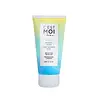What's inside
What's inside
 Key Ingredients
Key Ingredients

 Benefits
Benefits

 Concerns
Concerns

 Ingredients Side-by-side
Ingredients Side-by-side

Water
Skin ConditioningSodium Cocoyl Glycinate
CleansingSodium Lauroyl Isethionate
CleansingCocamidopropyl Betaine
CleansingGlycerin
HumectantCocamide DEA
EmulsifyingAcrylates Copolymer
Sodium Methyl Cocoyl Taurate
CleansingGlycol Distearate
EmollientSodium Chloride
MaskingPhenoxyethanol
PreservativeParfum
MaskingMethylparaben
PreservativeCitric Acid
BufferingPolyquaternium-7
Sodium Polyphosphate
Disodium EDTA
Ethylhexylglycerin
Skin ConditioningSodium Erythorbate
AntioxidantCI 77288
Cosmetic ColorantSodium Benzoate
MaskingCI 77492
Cosmetic ColorantCentella Asiatica Leaf Extract
Skin ConditioningTocopheryl Acetate
AntioxidantO-Cymen-5-Ol
AntimicrobialMagnesium Ascorbyl Phosphate
AntioxidantButyl Avocadate
Skin ConditioningSalicylic Acid
MaskingAsiaticoside
AntioxidantMadecassic Acid
Skin ConditioningAsiatic Acid
Skin ConditioningAmylopectin
Dextrin
AbsorbentXanthan Gum
EmulsifyingAlcohol
AntimicrobialWater, Sodium Cocoyl Glycinate, Sodium Lauroyl Isethionate, Cocamidopropyl Betaine, Glycerin, Cocamide DEA, Acrylates Copolymer, Sodium Methyl Cocoyl Taurate, Glycol Distearate, Sodium Chloride, Phenoxyethanol, Parfum, Methylparaben, Citric Acid, Polyquaternium-7, Sodium Polyphosphate, Disodium EDTA, Ethylhexylglycerin, Sodium Erythorbate, CI 77288, Sodium Benzoate, CI 77492, Centella Asiatica Leaf Extract, Tocopheryl Acetate, O-Cymen-5-Ol, Magnesium Ascorbyl Phosphate, Butyl Avocadate, Salicylic Acid, Asiaticoside, Madecassic Acid, Asiatic Acid, Amylopectin, Dextrin, Xanthan Gum, Alcohol
Water
Skin ConditioningGlycerin
HumectantPrunus Amygdalus Dulcis Oil
Skin ConditioningCetearyl Alcohol
EmollientButyrospermum Parkii Butter
Skin ConditioningLeuconostoc/Radish Root Ferment Filtrate
AntimicrobialPropanediol
SolventCera Alba
EmollientRosa Centifolia Flower Water
Skin ConditioningCetearyl Glucoside
EmulsifyingCetyl Palmitate
EmollientAloe Barbadensis Leaf Juice
Skin ConditioningXanthan Gum
EmulsifyingSodium Phytate
Helianthus Annuus Seed Oil
EmollientOryza Sativa Extract
AbsorbentTocopherol
AntioxidantActinidia Chinensis Fruit Extract
EmollientOctyldodecyl Myristate
EmollientFragaria Vesca Fruit Extract
AstringentCalendula Officinalis Flower Extract
MaskingZea Mays Starch
AbsorbentPyrus Malus Fruit Extract
Skin ConditioningSodium Benzoate
MaskingPotassium Sorbate
PreservativeCitric Acid
BufferingSodium Levulinate
Skin ConditioningWater, Glycerin, Prunus Amygdalus Dulcis Oil, Cetearyl Alcohol, Butyrospermum Parkii Butter, Leuconostoc/Radish Root Ferment Filtrate, Propanediol, Cera Alba, Rosa Centifolia Flower Water, Cetearyl Glucoside, Cetyl Palmitate, Aloe Barbadensis Leaf Juice, Xanthan Gum, Sodium Phytate, Helianthus Annuus Seed Oil, Oryza Sativa Extract, Tocopherol, Actinidia Chinensis Fruit Extract, Octyldodecyl Myristate, Fragaria Vesca Fruit Extract, Calendula Officinalis Flower Extract, Zea Mays Starch, Pyrus Malus Fruit Extract, Sodium Benzoate, Potassium Sorbate, Citric Acid, Sodium Levulinate
Ingredients Explained
These ingredients are found in both products.
Ingredients higher up in an ingredient list are typically present in a larger amount.
Citric Acid is an alpha hydroxy acid (AHA) naturally found in citrus fruits like oranges, lemons, and limes.
Like other AHAs, citric acid can exfoliate skin by breaking down the bonds that hold dead skin cells together. This helps reveal smoother and brighter skin underneath.
However, this exfoliating effect only happens at high concentrations (20%) which can be hard to find in cosmetic products.
Due to this, citric acid is usually included in small amounts as a pH adjuster. This helps keep products slightly more acidic and compatible with skin's natural pH.
In skincare formulas, citric acid can:
While it can provide some skin benefits, research shows lactic acid and glycolic acid are generally more effective and less irritating exfoliants.
Most citric acid used in skincare today is made by fermenting sugars (usually from molasses). This synthetic version is identical to the natural citrus form but easier to stabilize and use in formulations.
Read more about some other popular AHA's here:
Learn more about Citric AcidGlycerin is already naturally found in your skin. It helps moisturize and protect your skin.
A study from 2016 found glycerin to be more effective as a humectant than AHAs and hyaluronic acid.
As a humectant, it helps the skin stay hydrated by pulling moisture to your skin. The low molecular weight of glycerin allows it to pull moisture into the deeper layers of your skin.
Hydrated skin improves your skin barrier; Your skin barrier helps protect against irritants and bacteria.
Glycerin has also been found to have antimicrobial and antiviral properties. Due to these properties, glycerin is often used in wound and burn treatments.
In cosmetics, glycerin is usually derived from plants such as soybean or palm. However, it can also be sourced from animals, such as tallow or animal fat.
This ingredient is organic, colorless, odorless, and non-toxic.
Glycerin is the name for this ingredient in American English. British English uses Glycerol/Glycerine.
Learn more about GlycerinSodium Benzoate is a preservative. It's used in both cosmetic and food products to inhibit the growth of mold and bacteria. It is typically produced synthetically.
Both the US FDA and EU Health Committee have approved the use of sodium benzoate. In the US, levels of 0.1% (of the total product) are allowed.
Sodium benzoate works as a preservative by inhibiting the growth of bacteria inside of cells. It prevents the cell from fermenting a type of sugar using an enzyme called phosphofructokinase.
It is the salt of benzoic acid. Foods containing sodium benzoate include soda, salad dressings, condiments, fruit juices, wines, and snack foods.
Studies for using ascorbic acid and sodium benzoate in cosmetics are lacking, especially in skincare routines with multiple steps.
We always recommend speaking with a professional, such as a dermatologist, if you have any concerns.
Learn more about Sodium BenzoateWater. It's the most common cosmetic ingredient of all. You'll usually see it at the top of ingredient lists, meaning that it makes up the largest part of the product.
So why is it so popular? Water most often acts as a solvent - this means that it helps dissolve other ingredients into the formulation.
You'll also recognize water as that liquid we all need to stay alive. If you see this, drink a glass of water. Stay hydrated!
Learn more about WaterXanthan gum is used as a stabilizer and thickener within cosmetic products. It helps give products a sticky, thick feeling - preventing them from being too runny.
On the technical side of things, xanthan gum is a polysaccharide - a combination consisting of multiple sugar molecules bonded together.
Xanthan gum is a pretty common and great ingredient. It is a natural, non-toxic, non-irritating ingredient that is also commonly used in food products.
Learn more about Xanthan Gum